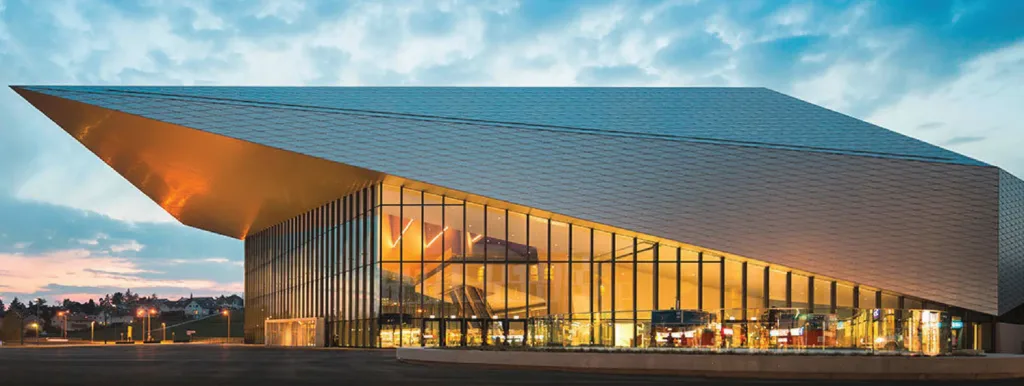

In the evolving landscape of solar energy, the integration of aesthetics and functionality has emerged as a crucial aspect, especially in the realm of building integrated photovoltaics (BIPV)
The advent of colored BIPV, marrying the technological advancements of photovoltaics with an array of PV colors, caters to both efficiency and architectural beauty. This synergy not only enhances the visual comfort and aesthetic appeal of structures but also opens up a vista of customization possibilities. As the demand for transparency, reflectance control, and color tuning grows, the role of PV colors in optimizing solar irradiation absorption while maintaining the architectural integrity of buildings has become increasingly significant.
Relevance in Modern Architecture

The development of colored BIPV modules allows architects new opportunities to redefine the aesthetic language of photovoltaics. Now, Manufacturers can customize BIPV glass modules not only in performance but also in appearance, offering designs where PV cells can be camouflaged behind colored patterns. These patterns can effectively disguise the traditional appearance of PV cells, making them more visually appealing and integrative with the building’s design.
However, this innovation has challenges, particularly in balancing aesthetic quality with energy and electrical efficiency, reliability, and safety. The pursuit to optimize this balance drives ongoing innovation in the field.
Research and development efforts are intensively focused on producing BIPV products that are aesthetically pleasing and technically sophisticated. These efforts aim to make such products more affordable and efficient in terms of power generation, thereby enhancing their marketability and practicality.
Technological Innovations in Colored BIPV
Researchers from Switzerland have developed an innovative color characterization technique specifically for BIPV. This new method, known as the large area illumination (LAI) colorimeter, utilizes a fiber optic spectrometer combined with large area illumination to address the limitations of traditional color characterization techniques. These conventional methods often struggle to accurately determine color when it is obstructed by a transparent layer, such as the solar PV laminate found in BIPV systems.

SwissTech Convention Center
The SwissTech Convention Center, located in the Northern quarter of the École Polytechnique Fédérale de Lausanne (EPFL), in the area of the Lake Geneva Region, is the first application of multicolored dye photovoltaic cells. The panels, installed as a horizontal shading system in the western facade, are arranged in 65 colored columns, with 5 different shades of red, green, and orange, providing a unique color tone to the light transmitted into the interior hall.
Current Colored BIPV Products
The current market for colored BIPV showcases a variety of technical solutions for coloring different parts of a BIPV module, including glass, polymers, and PV-active layers. The industry offers a range of products that feature anti-reflection coatings on solar cells, colored and semi-transparent PV-active layers, special solar filters as layers, coatings, or interlayers with colors or patterns, colored polymeric encapsulant films, and modified front glass by printing, coating, or alternative finishing. These innovations not only enhance the aesthetic appeal but also maintain the functionality essential for energy efficiency.
Color Tuning and Efficiency
The relationship between color and efficiency in BIPV is complex and influenced by the fundamental principles and limits of color perception under solar irradiation.
The coloration on the front cover glass means that the solar radiation energy of a specific wavelength (depending on the color) within the visible light region in the solar spectrum passes through the front cover glass and cannot reach the solar cell before being reflected. Consequently, due to the decrease in transmittance, the efficiency of the colored BIPV module is lower than that of the general BIPV module.
Colored BIPV modules employ various state-of-the-art color implementation technologies such as digital glass printing, mineral coatings, and plasmonic coatings on PV-active layers, which include crystalline Si cells. These technologies are designed to optimize the visual appeal of solar panels while maintaining energy efficiency.
Impact on Power Generation

The integration of color in BIPV modules directly impacts power generation. Innovations such as colored cover glasses and thin film coatings on cover glass are tailored to enhance aesthetic integration into buildings without significantly compromising the power output. These solutions address the market’s need for visually appealing solar energy solutions that align with architectural designs and client preferences.
Generally speaking, colored BIPV can be applied in all the segments, namely facade, roofing, as well as shading, balcony glazing, etc. Some examples are colored BIPV facades for representative offices and public buildings, colored BIPV facades for residential high-rise buildings, and colored BIPV roofs for residential low-rise buildings.
| Basis | Normal BIPV | Colored BIPV |
|---|---|---|
| Appearance | Typically black or dark blue in color | Variety of colors achieved through different techniques |
| Aesthetics | Less visually appealing, may not integrate well with building design | Improved aesthetic integration with building design |
| Power Output | Higher power output as no color modifications are made | Lower power output due to color coatings/filters reducing light absorption |
| Cell Type | Typically uses standard crystalline silicon (c-Si) solar cells | Can use c-Si cells with modified anti-reflective coatings, or thin-film/organic PV with inherent color |
| Transparency | Generally opaque | Can be semi-transparent depending on the coloring technique used |
About Ornate Solar
Ornate Solar is a leading solar company with 10 years of experience in the industry and the mission to reimagine the way solar is installed worldwide.
From advanced solar panels, best solar inverter solutions, and high-quality accessories to the unique InRoof that turns panels into the primary roof, we develop and deliver solutions that are modern, reliable, and effective.
If you are exploring InRoof solution, reach out to us at 1800 2026 252 to discuss your options.










Leave A Comment